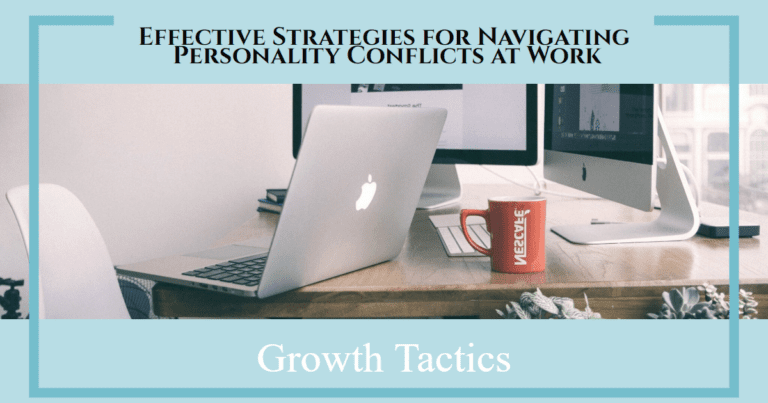Conflicts are bound to happen in the workplace. However, personality conflicts can be particularly challenging to navigate. These clashes between individuals with differing personalities, values, and work styles can lead to tension, reduced productivity, and a negative work environment. In this blog post, we will explore effective strategies for dealing with personality conflicts at work and promoting a harmonious work environment.
Jump To Section
Understanding the Causes of Personality Clashes
Before we get into the strategies for managing personality conflicts, it is crucial to understand the underlying causes that contribute to these clashes. By recognizing and understanding the root causes, we can better address and resolve the conflicts. Personality clashes can result from various factors, including:
Incompatible Personalities
Personality clashes often arise when individuals have different temperaments, communication styles, or ways of approaching work. For example, one person may be outgoing and assertive, while another may be introverted and more reserved. These differences can lead to friction and misunderstandings, especially when it comes to collaboration and decision-making.
Conflicting Work Approaches
Individuals have unique work approaches and preferences. Some people are more detail-oriented and prefer to follow established processes, while others may be more flexible and rely on their intuition. When these conflicting work approaches collide, it can result in disagreements and conflicts.
Differing Cultural Backgrounds
In today’s diverse workplace, clashes may arise from differences in cultural backgrounds. Different cultural norms, values, and communication styles can lead to misunderstandings and conflicts. The varying expectations and perspectives of individuals from different cultures may require extra effort to ensure effective collaboration and understanding.
Misunderstandings and Communication Issues
Miscommunications or a lack of effective communication can contribute significantly to personality conflicts. When messages are misunderstood, unclear, or not properly expressed, it can lead to confusion and interpretations that may escalate conflicts. This includes factors such as non-verbal cues, tone of voice, and body language.
Workplace Dynamics and Organizational Factors
Certain workplace dynamics and organizational factors can contribute to personality conflicts. For instance, high-stress environments, a lack of clear roles and responsibilities, limited resources, or poor leadership can create an atmosphere that is ripe for conflicts to arise. These factors can heighten tension and amplify personality clashes.
By understanding these underlying causes, we gain insight into why personality conflicts occur and can identify strategies to address and manage them effectively. It is essential to approach conflicts with empathy, open-mindedness, and a willingness to find common ground. By doing so, we can foster a more harmonious and productive work environment.
Strategies for Managing Personality Conflicts in the Workplace
1. Promote a Positive Work Environment
Promoting a positive work environment is crucial to preventing and resolving workplace conflicts. A positive work environment is one where employees feel valued and respected, their opinions are heard, and they are encouraged to collaborate and communicate openly. Creating a culture of inclusiveness goes a long way in minimizing the likelihood of personality clashes.
To promote a positive work environment, encourage open communication, active listening, and respect for others’ opinions. When colleagues feel safe and comfortable sharing their thoughts and concerns without fear of judgment, they are more likely to work collaboratively and be productive.
Additionally, it creates opportunities for team-building activities and encourages employees to interact outside of work. Celebrate successes and milestones, and foster a culture of appreciation and recognition. When employees feel valued and appreciated, they are more likely to go the extra mile and less likely to engage in conflicts or negative behaviors.
2. Address Conflicts Early
It’s essential to address conflicts early to prevent them from becoming bigger issues. Ignoring conflicts only allows them to fester and potentially escalate, leading to more significant problems down the line. Encourage employees to speak up about their concerns and provide a safe space for open dialogue.
When addressing conflicts, listen carefully to both parties’ perspectives, identify the underlying issues, and seek a mutually beneficial solution. By taking a proactive approach to conflicts, you can prevent them from hindering productivity or damaging workplace relationships.
It’s equally important to approach conflict resolution with a positive mindset. Rather than seeing conflicts as problems, view them as an opportunity to learn and grow. Use conflicts as an opportunity to identify areas for improvement and implement changes that will benefit the organization as a whole.
3. Seek Mediation
If conflicts persist and cannot be resolved through informal discussions, consider involving a professional mediator. Mediators can help facilitate communication between the conflicting parties, identify the underlying issues, and guide the resolution process. They provide an unbiased perspective and help the parties reach a consensus.
In situations where conflicts are too complex or emotionally charged to resolve through informal discussions, mediation can provide valuable benefits. Mediators can help parties work towards a solution that is acceptable to both parties and can provide a fresh perspective that enables both parties to understand each other’s perspectives.
Mediators can also provide formal procedures and guidelines for resolving conflicts, and can create parameters for decision-making that everyone involved can agree upon. By involving a neutral third party, you reduce the likelihood of personality conflicts escalating and can achieve a resolution that is fair to all parties involved.
4. Encourage Understanding and Empathy
Encouraging understanding and empathy among team members is essential for resolving personality conflicts. By promoting a culture of empathy, individuals are encouraged to try to understand each other’s perspectives and step into each other’s shoes. When empathy is practiced, it fosters mutual respect and cooperation among colleagues.
One effective way to encourage empathy is through open and honest communication. Encourage team members to actively listen to each other and attempt to understand the underlying motivations, emotions, and experiences driving their colleagues’ actions. This understanding can help dissolve misunderstandings and reduce conflicts.
Leaders and managers can also lead by example, demonstrating empathy in their interactions with team members. By showing empathy towards differing opinions and offering support to those in conflict, leaders create an environment that values understanding and fosters cooperation. This can have a positive ripple effect on the entire team, encouraging others to follow suit.
5. Develop Conflict Resolution Skills
Providing training and resources to help employees develop conflict resolution skills is crucial for managing personality conflicts effectively. Conflict resolution skills include problem-solving techniques, effective communication strategies, and the ability to negotiate and find mutually beneficial solutions.
Through training sessions and workshops, employees can learn how to engage in constructive discussions, actively listen to each other, and respectfully express their viewpoints. These skills enable individuals to navigate conflicts with professionalism and work towards resolving them in a manner that satisfies all parties involved.
It is essential to reinforce the importance of these skills regularly. Provide ongoing support and opportunities for employees to practice and refine their conflict resolution skills. This can include role-playing scenarios, case studies, or real-life situations where employees can apply what they have learned. By consistently developing these skills, your team members will become more equipped to handle personality conflicts as they arise.
6. Establish an Open-Door Policy
Creating an open-door policy is crucial in preventing and managing personality conflicts. An open-door policy ensures that employees feel comfortable expressing their concerns, seeking advice, or sharing their perspectives without fear of retribution or judgment. It promotes an environment of trust, open communication, and transparency.
To establish an open-door policy, leaders and managers should demonstrate approachability and encourage feedback and suggestions. Holding regular one-on-one meetings with team members can provide a dedicated space for individuals to discuss any conflicts or concerns they may have. By actively listening and providing support, leaders can address conflicts early and provide guidance or mediation if necessary.
It is also vital to communicate the open-door policy effectively to all employees. This can include providing an overview of the policy during orientation or onboarding sessions, clearly stating the process for scheduling meetings with leaders or sharing anonymous feedback, and periodically reminding employees that their voices are valued and heard.
7. Address Underlying Issues
In some cases, personality conflicts may be a symptom of deeper underlying issues within the organization. It is important to look for patterns in conflicts and identify any systemic problems that may be causing or exacerbating these conflicts. These underlying issues may include unclear roles or responsibilities, ineffective communication channels, conflicting goals or priorities, or a lack of resources and support.
Addressing these underlying issues can help prevent future conflicts and improve employee satisfaction. Conduct a thorough analysis of the organization’s structure, processes, and culture to identify areas that may contribute to personality conflicts. Once identified, take proactive steps to address these issues, such as clarifying roles and responsibilities, improving communication channels, establishing shared goals, and providing necessary resources and support to employees.
By addressing these underlying issues, you can create an environment that minimizes the likelihood of personality conflicts arising and promotes a culture of collaboration and cooperation.
8. Encourage Collaboration and Team Building
Promoting collaboration and team-building activities is crucial in fostering cohesion among team members. By encouraging employees to work together on projects, initiatives, or problem-solving tasks, you can help bridge gaps caused by incompatible personalities and conflicting work styles.
Team-building activities can include workshops, retreats, or group exercises that encourage communication, trust-building, and understanding among team members. These activities provide opportunities for employees to interact outside of their regular work tasks and develop a sense of camaraderie.
Collaboration, on the other hand, involves actively seeking input from different team members, encouraging diverse perspectives, and valuing each individual’s contributions. By promoting a collaborative culture, you create an environment where employees are more likely to recognize and appreciate the strengths and abilities of their colleagues, minimizing the potential for personality conflicts.
9. Lead by Example
As a leader, it is essential to lead by example when it comes to managing personality conflicts. Demonstrate effective conflict resolution skills, actively listen to your team members, and show empathy towards differing opinions and perspectives.
By modeling positive behaviors, you create a standard for how conflicts should be handled within your team or organization. When team members see their leaders approaching conflicts with respect, open-mindedness, and a focus on finding common ground, they are more likely to emulate these behaviors and similarly handle conflicts.
Additionally, leaders can provide guidance and support to help team members navigate conflicts constructively. Encourage open and honest communication, facilitate discussions, and provide a platform for team members to voice their concerns.
10. Maintain Confidentiality
Confidentiality is paramount when dealing with personality conflicts. Employees need to feel safe and trust that their discussions and concerns will be handled discreetly. It is essential to communicate to all parties involved that any discussions related to conflicts will be kept confidential.
Maintaining confidentiality not only protects individual privacy but also encourages open and honest communication. Employees are more likely to share their concerns and insights if they feel assured that their privacy will be respected.
Clearly communicate the importance of confidentiality and ensure that all employees are aware of the organizational policies regarding privacy and confidentiality. This helps create a safe space for employees to express their concerns freely, which is crucial for effectively managing and resolving personality conflicts.
Conclusion
Navigating personality clashes at work can be challenging, but it is essential for maintaining a positive work environment. By understanding the causes, addressing conflicts early, seeking mediation when necessary, and promoting a collaborative and empathetic work culture, you can effectively manage personality clashes and create a harmonious workplace Remember, conflicts are a natural part of any organization, but with the right strategies and proactive approach, they can be resolved in a manner that benefits everyone involved.


